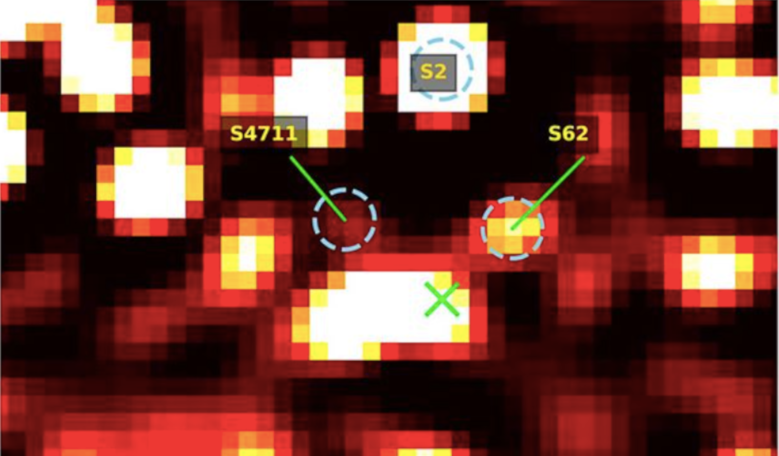A pair of incredible stars, one of which takes just 7.6 years to orbit the supermassive black hole at the centre of our galaxy and the other hurtles round Sagittarius A* at speeds of 24, 000 kilometres per second, have been found by a team of European scientists using the Very Large Telescope (VLT) in Chile.
Circling Sgr A* from a distance that is comparable to the size of our Solar System, is a small cluster of high velocity stars, known as the S-stars.
Being so close to the galactic centre, these super-fast stars have in the past been difficult to detect, as their light has to compete with radiation from millions of other objects that lie between them and Earth.
However with the development of larger telescopes and advanced analysis techniques more and more of these unusual stars have been found;
One of the brightest members of that cluster found so far is S2. S2 made headlines when it helped scientists establish that a super massive black hole with a mass of about 4 million suns was was hiding at the centre of our galaxy.
When it was discovered, S2 had the shortest observed orbital period of any known star and was calculated to take approximately 15.9 years to complete one orbit around Sgr A*.
Since then some new kids on the block have knocked S2 off the top spot; discovered by Florain Peißker and colleagues, s62 was found to orbit Sgr A* in approximately 9.9 years and now Peißker and team have found another, S4711.
S4711 is a large, hot star that races around Sgr A* in just 7.6 years; an orbital period “which is unbelievable,” said Peißker in an interview with ROOM. However S4711 is also hiding another ace up its sleeve, as Peißker speculates that the super-fast star could be the first known “squeezar” candidates.
Squeezars were first proposed by Tal Alexander and Mark Morris in 2003 and are described as a class of star in a highly eccentric orbit (more elongated than circular) around a super massive black hole that can be categorised as hot and cold.
The difference in temperature comes from the different ways the stars experience tidal interactions with the super massive black hole they orbit. Either way, squeezers are postulated to be very luminous and can experience increases of several thousand degrees says Peißker, who is at the University of Cologne in Germany, adding that the team derive a stellar temperature of 10000 K for S4711 (for comparison the surface temperature of the Sun is 5,778 K).
Remarkably, Peißker and colleagues recent discovery includes not one, but a few potential squeezar candidates; along with S4711, the others are S4712, S4713, S4714 and S4715 and one of those is another record-breaker in its own right.
Zooming around Sgr A* at a blistering 24, 000 kilometres a second at its closest point (its pericentre), is S4714. This phenomenal speed is equivalent to eight percent the speed of light, which makes S4714 the fastest known star near a SMBH yet. S4714 also gets closer to Sgr A* than any of the other newly detected stars too and gets to within 12.6 AU (about 13 times the Earth-Sun distance) of the behemoth black hole; for comparison S62 has a pericentre distance of 17.8 AU and S2 orbits at 119.3 AU away from Sgr A*.
How did they get so close to our galaxy’s SMBH? The team speculate that the stars were once part of a stellar binary system, then one got kicked out as a runaway star, and the other one was then caught by Sgr A* on a highly eccentric orbit a process known as the Hills Mechanism.
Excitingly, these discoveries are unlikely to be the last and it is most certain that more super fast, close-in stars will be found in the future, Peißker told ROOM, especially when the Extreme Large Telescope (ELT) starts observing, he added.
When completed, the ELT will be the largest optical/near-infrared telescope in the world and will gather 13 times more light than the largest optical telescopes existing today. The ELT is expected to begin operations in 2025 from its Cerro Armazones site in Chile.











